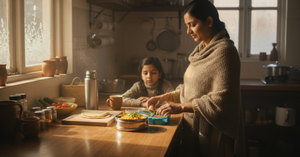A balanced meal plan for kids is essential for their growth, development, and overall health. A well-structured meal plan can ensure that children receive the necessary nutrients for their active lifestyles. In this blog, we will explore the top 10 ways to create a balanced meal plan that focuses on kids' nutrition and effective meal planning strategies.
Top 10 ways to create a balanced meal plan
#1. Understand Nutritional Needs
Kid's nutritional requirements vary based on their age, activity level, and growth stage. Generally, kids need a diet rich in:
- Carbohydrates: For energy, go for whole grains like brown rice, oats, and whole-wheat bread.
- Proteins: Essential for growth; include sources like lentils, beans, dairy products, eggs, chicken, and fish.
- Fats: Important for brain development; focus on healthy fats like nuts, seeds, and avocados.
- Vitamins and Minerals: Make sure that various fruits and vegetables are included in the meal to provide essential nutrients.
#2. Include Variety
A balanced meal plan should include a wide range of foods to prevent monotony and encourage kids to try new flavors. Aim to combine different colors and textures in each meal. For instance:
- Breakfast: Oatmeal topped with berries and nuts.
- Lunch: A colorful salad with mixed greens, cherry tomatoes, cucumbers, and grilled chicken.
- Dinner: Stir-fried vegetables with tofu served over brown rice.
#3. Meal Prep Together
Involving your children in the meal preparation process makes them more interested in healthy eating. Allow them to help choose recipes or prepare simple dishes. This will teach them valuable cooking skills and foster a positive relationship with food.
#4. Plan Balanced Meals
Each meal should have a balance of carbohydrates, proteins, and fats. A good rule of thumb is (example):
- Breakfast: Whole grain toast with nut butter and a piece of fruit.
- Lunch: A wrap filled with hummus, grated carrots, spinach, and sliced bell peppers.
- Dinner: Grilled fish with quinoa, steamed broccoli, or lentil soup with whole-grain bread and a side salad.
#5. Maintain Regular Meal Times
A consistent eating schedule helps regulate hunger cues and promotes healthy eating habits. Aim for three primary meals and two nutritious snacks each day.
- Snacks: Fresh fruits, yogurt, or whole-grain crackers with cheese.
#6. Focus on Healthy Snacks
Instead of sugary snacks or processed foods, provide nutritious options that sustain energy levels throughout the day. Consider:
- Sliced vegetables with hummus
- Fruit smoothies
- Trail mix made with nuts and dried fruits
#7. Limit Processed Foods
Encourage whole foods over processed items whenever possible. Processed foods often contain added sugars, unhealthy fats, and preservatives that can negatively impact children's health. Instead of chips or sugary cereals, opt for:
- Popcorn (without butter)
- Whole grain cereals
- Fresh fruit or vegetable sticks
#8. Hydration is Key
Adequate hydration is crucial for children's health. Please encourage them to have plenty of water throughout the day instead of sugary drinks or sodas. You can make it more appealing by adding slices of fruit like lemon or cucumber.
#9. Educate About Nutrition
Teaching children about nutrition can empower them to make healthier choices as they grow older. Discuss the benefits of different food groups and why they are important for their bodies. Use simple language and engaging activities to make learning fun.
#10. Consult Professionals
If you're unsure about your child's nutritional needs or how to create a balanced meal plan tailored to them, consult a pediatrician or a dietitian. They provide personalized advice based on your child's specific needs.
Frequently Asked Questions (FAQs)
What should be included in a balanced meal plan for kids?
A balanced meal plan should include:
- Carbohydrates (whole grains).
- Proteins (meat, dairy, legumes).
- Healthy fats (nuts, avocados).
- Plenty of fruits and vegetables.
How many calories do kids need daily?
Children typically require between 1,000 to 2,200 calories daily, depending on their age and exercise level.
How can I make healthy meals appealing to my kids?
To make meals more attractive, involve them in meal prep, use colorful ingredients, and present food in fun shapes or arrangements.
What are some quick, healthy snacks for kids?
Healthy snacks include yogurt with fruit, carrot sticks with hummus, whole grain crackers with cheese, or fruit smoothies.
Conclusion
By following these meal planning strategies into your child's diet, you can create a balanced meal plan that supports your kids' nutrition growth while fostering healthy eating habits that last a lifetime.








Be the first one to comment on this story.